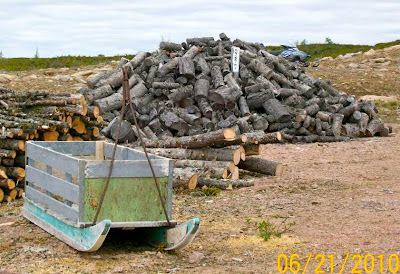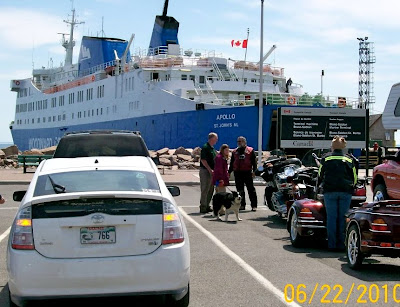This is an account of a drive starting June 11, 2010 from our Maine home to Gaspe to Labrador to Newfoundland to Nova Scotia and back home, in our 2006 Prius. We are Dick and Margery Dreselly, very senior citizens who retired in 1987 to Brunswick, Maine. In 2021 we're in a "senior complex" in South Portland, Maine. To show what we looked like, here's a 2004 photo, near Cape Horn --> xx
The names "Newfoundland" and "Labrador" are confusing. Their area was called just "Newfoundland" when it was a separate country, a British dominion with its own postage stamps, until after it became a Canadian province in 1949, with the voters opting for "confederation" with Canada narrowly exceeding those preferring to remain a British dominion or even to become a USA state. In 2001 the provincial name was changed to "Newfoundland and Labrador". The Labrador part is mainland north of the St. Lawrence River, bigger (the size of Arizona) and wilder (population 42,000 with no town population above 10,000) and colder (sub-Arctic). The Newfoundland part is an island that splits the mouth of the St. Lawrence River, is the size of Virginia, has 480,000 people with 100,000 of them in St. John's, and has an average climate between those of Maine and Labrador.
Labrador was a challenging adventure for us. On this trip we drove most of its roads, which is a 1060-mile arc extending north from Baie-Comeau on the St. Lawrence river through Quebec to Labrador City and Goose Bay and back south to the St. Lawrence at Red Bay, Quebec. The 693 miles of mostly paved road from Baie-Comeau to Goose Bay has been there for several decades. The 356 mile road from Goose Bay to Red Bay was only a snowmobile trail until a road between those towns was begun in 1986 and officially completed in December 2009, without pavement. However, on our trip 30 miles of that segment were still under construction. We're glad we went, but probably won't go to Labrador again, just Newfoundland.
Most of our drive north of the St. Lawrence was sub-Arctic, with very short trees, offshore ice and icebergs and occasional polar bears to July. For us that also meant very few people, cars, paved roads, facilities, and hours of darkness.
In May the newest part of the road, from Goose Bay to Cartwright, was snowy and muddy, impassable to cars. It became barely drivable by cars in late May. The arc is so new that there wasn't much about it on the Internet, but now see these: click . From near Red Bay we crossed on a 1 1/2 hour ferry to the island of Newfoundland, drove the length of that island twice, and arrived home on July 6.
Newfoundland, its wonderful people and scenery, subtly changed our lives. We were lured there in 1970 by Farley Mowat's book "The Boat Who Wouldn't Float".
We returned in 1999 and 2010.
**************************************
If JFK could say, "Ich bin eine Berliner", I can say, "I am Canadian". We are loyal Americans who also love Canada, and have travelled far in that uncrowded second biggest country in the world. We admire its government and economy (click). We know Canada is not perfect, and a few Canadians don't like Americans, but we've liked nearly all the Canadians we've met or read about.
Of those many Canadian B&Bs at which we've stayed, all but one were operated by couples we would have liked as neighbors. By a slight margin, the friendliest Canadians and most interesting Canadian experiences we've found so far have been in far eastern Canada. Another overwhelming impression of Canada is "unspoiled". That doesn't mean "rural", considering its ultramodern cities, or "backward", considering their greater longevity due to a widely supported medical system,. We are impressed that although some Canadians are rich, there seem to be hardly any who are obscenely rich or very poor.
We've travelled twice by Toyota and once by Cessna from Maine to Alaska, of course via Canada. We've driven to all 13 provinces and territories of Canada except Nunavut (click) , the new mostly-aboriginal nearly-roadless Arctic territory. We've driven to some of Canada's extreme corners: Victoria BC, Inuvik on the Arctic Ocean, St. John's Newfoundland, and by boat to the northernmost Inuit (click) community in Labrador. We've travelled many times by car and Cessna from home to adjacent New Brunswick (NB) and Nova Scotia. Twice we've flown the Cessna to Toronto. Twice we've sailed a sloop to St. John NB and through the Reversing Falls of the St. John River to the placid labyrinth upstream.
When we drove and ferried to Newfoundland in 1999 its economy had been devastated by the near end of cod fishing. Furnished homes were sold for a pittance ($3,500 or so) by jobless fishermen who migrated to the oil fields of Alberta. In 2010 we found our assumptions overturned. Newfoundland had adjusted well. We asked about the economy in several coastal villages, which all had neatly maintained homes and shiny cars. Their men worked in western Canada mines, especially in Fort McMurray, Alberta, earning high wages in the oil sands boom. They came home and remitted money regularly, like Mexicans working in the USA. In some of those little towns real estate prices had quintupled in 11 years, we were told.
If JFK could say, "Ich bin eine Berliner", I can say, "I am Canadian". We are loyal Americans who also love Canada, and have travelled far in that uncrowded second biggest country in the world. We admire its government and economy (click). We know Canada is not perfect, and a few Canadians don't like Americans, but we've liked nearly all the Canadians we've met or read about.
Of those many Canadian B&Bs at which we've stayed, all but one were operated by couples we would have liked as neighbors. By a slight margin, the friendliest Canadians and most interesting Canadian experiences we've found so far have been in far eastern Canada. Another overwhelming impression of Canada is "unspoiled". That doesn't mean "rural", considering its ultramodern cities, or "backward", considering their greater longevity due to a widely supported medical system,. We are impressed that although some Canadians are rich, there seem to be hardly any who are obscenely rich or very poor.
We've travelled twice by Toyota and once by Cessna from Maine to Alaska, of course via Canada. We've driven to all 13 provinces and territories of Canada except Nunavut (click) , the new mostly-aboriginal nearly-roadless Arctic territory. We've driven to some of Canada's extreme corners: Victoria BC, Inuvik on the Arctic Ocean, St. John's Newfoundland, and by boat to the northernmost Inuit (click) community in Labrador. We've travelled many times by car and Cessna from home to adjacent New Brunswick (NB) and Nova Scotia. Twice we've flown the Cessna to Toronto. Twice we've sailed a sloop to St. John NB and through the Reversing Falls of the St. John River to the placid labyrinth upstream.
When we drove and ferried to Newfoundland in 1999 its economy had been devastated by the near end of cod fishing. Furnished homes were sold for a pittance ($3,500 or so) by jobless fishermen who migrated to the oil fields of Alberta. In 2010 we found our assumptions overturned. Newfoundland had adjusted well. We asked about the economy in several coastal villages, which all had neatly maintained homes and shiny cars. Their men worked in western Canada mines, especially in Fort McMurray, Alberta, earning high wages in the oil sands boom. They came home and remitted money regularly, like Mexicans working in the USA. In some of those little towns real estate prices had quintupled in 11 years, we were told.
PS on 8-23-2015: Because oil prices have collapsed to under $50 per barrel, there's far less activity in Fort McMurray, so less money is being remitted to Newfoundland. Houses there are cheaper again, and also the Canadian dollar has fallen to 76 USA cents.
Each spring and early summer the "Labrador current" brings a parade of icebergs from Greenland to near the shores of Labrador and Newfoundland. Sometimes polar bears ride the icebergs until they are near enough to swim to land. These were early June 2010 warnings from Cartwright, on our route:
"The new road from Cartwright to Goose Bay is open but there remain about 50 kms to be properly finished. It is advised that cars stay off this section yet, as it is quite rough and mud can be deep."."A polar bear warning has been issued for the coast of Labrador, the first this year".
A recent bear sighting in the coastal town of Cartwright had prompted the advisory from the
Newfoundland and Labrador Department of Natural Resources. No polar bear advisories have been issued for the island of Newfoundland so far this year. In the past, they have been issued after bears came to the island on pack ice from the north. The bears get on the pack ice to hunt seals. Wildlife officials offered this advice to anyone who may encounter a polar bear:
Remain calm.Give the bear space.Back away, get out of the situation, but never run.If you must speak, do so calmly and firmly."
Like "Nice bear, DO NOT eat us". We only saw black bears.
Besides reading what I've written, you can:
* CLICK on an entry on the list at right to go directly to that subject.
* CLICK on the websites in the narrative for more information.
* COMMENT... by phone (207-352-7064), visit, paper, or email is invited.
* CLICK on the websites in the narrative for more information.
* COMMENT... by phone (207-352-7064), visit, paper, or email is invited.
You can leave a comment at the end of any subject, like this one: click on the slanted pencil.
* ENLARGE A PHOTO... Just click on it.
* ENLARGE A PHOTO... Just click on it.
For more information on this route and our trip: click and click .
Since the last road link was finally completed in 2010, we were among the first people to drive it.
Since the last road link was finally completed in 2010, we were among the first people to drive it.
Note: formatting in this blog is quite unpredictable.

































